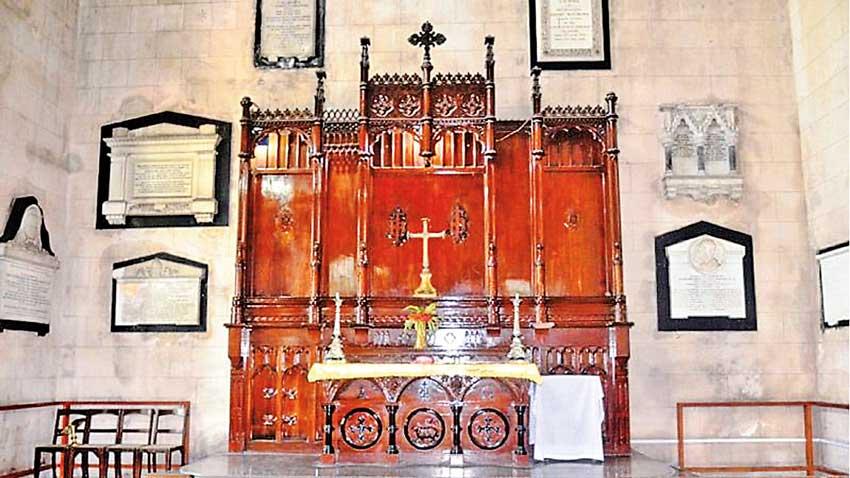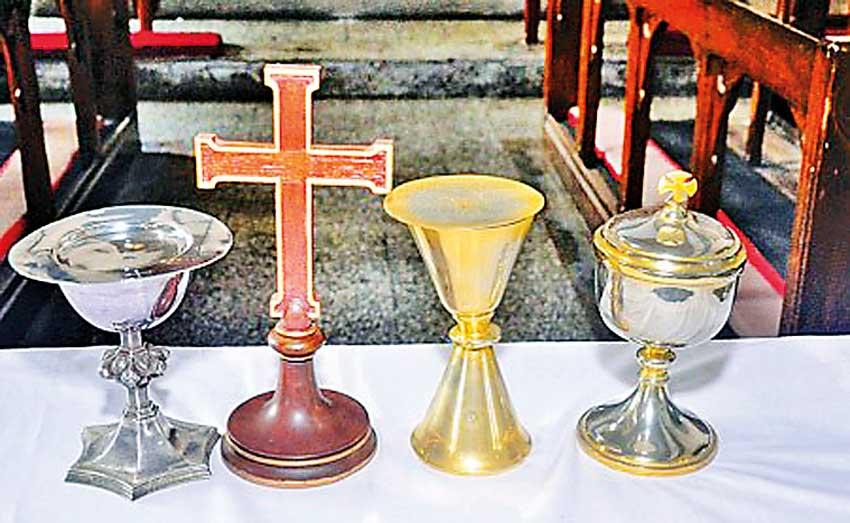Reply To:
Name - Reply Comment

Church has witnessed the victories and vicissitudes of life
It remains deeply-rooted as a haven of prayer and rest
Restoration halted due to COVID-19 situation
 Today, the surroundings of Colombo Harbour have become clamorous and overcrowded, but two centuries ago, this landscape was serene and tranquil – an era when horse-drawn carriages trotted along the streets. Some of the magnificent and archaic buildings that once dominated the municipal skyline are now hidden to Colombo residents and remain partly obscured in a cloud of faded glory.
Today, the surroundings of Colombo Harbour have become clamorous and overcrowded, but two centuries ago, this landscape was serene and tranquil – an era when horse-drawn carriages trotted along the streets. Some of the magnificent and archaic buildings that once dominated the municipal skyline are now hidden to Colombo residents and remain partly obscured in a cloud of faded glory.
Such an opulent gem is the beautiful church of St. Peter, belonging to the Anglican Church of Sri Lanka, situated in the north of Grand Oriental Hotel in Colombo Fort and adjacent to the present day police headquarters. The church, constructed 200 years ago as an official residence of the Dutch Governor, has indeed stood the test of time.
Historian R.L. Brohier records that there existed a Dominican monastery in 1672 in this location. Dominican friars had arrived during Portuguese occupation. Their pious order dates back to 1216. The Dutch wielded their authority over Ceylon. Its administration put up this magnificent building with a resplendent view of the harbour. It was in this edifice that our once powerful Kandyan kings presided over council meetings. Its engravings are of interest to architecture enthusiasts as they illustrate the evolution of colonial architectonic from the small Portuguese chapel that originally made way to the deluxe residence of the Dutch Governor.

Incumbent vicar, Rev. Fr. Chandran Crispus explained: “Decades ago, there was a need for Anglican adherents to gather for worship and prayer in Colombo. It was against this backdrop that Governor Sir Frederick North published a gazette notice in 1804 proclaiming worship services would be held every Sunday at 04:30 p.m.”
Under the British administration, the mansion became the Government House for the first years of Sir Frederick North’s rule. This is why the structure does not resemble the formation of a cross. On a subsequent request by Lieutenant General Sir Edward Barnes, Governor of Ceylon, the grand mansion was consecrated as a garrison church on May 22, 1821by Bishop of Calcutta, Dr. Thomas Middleton. From this point on, it became St. Peter’s Church.
Sitting adjacent to the port, the church laid emphasis on caring for the spiritual and emotional needs of seafarers. This mission continues even today under Rev. Fr. Chandran Crispus who is also the Port Chaplain.
“Crews from many countries come to this church once they get their shore pass from Colombo Harbour. Sailing for weeks or months creates a spiritual void in these sailors and merchant navy officers. We also get visitors from cruise ships who admire this historic church. The mission to seamen is another vital service rendered by this parish,” the priest said. “St. Peter’s Church is a historic jewel. Unfortunately, during the dark chapters of our nation, this area was a high-security zone as it was next to the police headquarters and our congregation declined. We were not able to maintain the building. We wanted to preserve this magnificent church and begin a mild restoration to celebrate 200 glorious years of Christian ministry, bearing in fact the great historical value of the structure. The restoration idea was halted due to the COVID-19 situation.”
It was during the British era that the present portico and sprawling verandas supported by classical columns were added. From 1810 to 1820, a section of the building was used as a court. A scene remembering Sir Alexander Johnston’s tenure as Chief Justice depicts the interior of the building when it was temporarily used as a courthouse. The doors of the sanctuary are unique because they could be opened at the top half as windows. The British flag originally hoisted in 1821 is still suspended from an iron mast on the rear left wall of the church encased in polythene. A vibrant choir sang here decades ago. The organ has since been removed and its impression lies on the cemented floor. The main altar carved in solid wood is the highlight of this sacred edifice. Candle stands sit on the chantry, relics of a bygone era.
The church bears testament to many distinguished sons of that era as memorial plaques line its mildly caliginous walls. Among them are those of William Tolfrey who undertook the daunting task of bringing forth the first Sinhala translation of the Holy Bible. Prior to this, he worked as an Assistant Commissioner of Revenue. The others are Reginald Heber, the Lord Bishop of Calcutta and George Steuart, founder of the company that still operates after his name. A brass plate has on it a record of the 2nd Battalion of Sri Lanka Light Infantry receiving the Queen’s Regimental Colours in March 1922 from His Royal Highness Edward, Prince of Wales. A marble slab also pays tribute to soldiers from the Worcestershire Regiment who laid their lives between 1904 and 1906. A scroll etched in cement remembers the life of Rev. Thomas Twilsten, the first archdeacon of Colombo who died in 1824.
In one section, we find small wooden chairs. Rev. Fr. Chandran Crispus explains: “Back in the day, parents brought their children to Sunday school and each child had his or her chair carried by a servant. When the British left, a few of these chairs were left behind.”
St. Peter’s Church has witnessed the victories and vicissitudes of life and remains deeply-rooted as a haven of prayer and rest. A service is conducted on Wednesdays for the busy office workers and executives in the area. The church is open on weekdays from 07:30 a.m. to 05:00 p.m. An epigraph on a pillar best encapsulates the Christian life: “Life’s race well run, life’s work well done, life’s crown well won.”